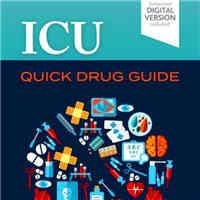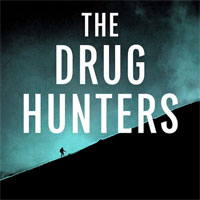Tag: drugs
10 Reasons for Pharmacy Professionals Presence in the ICU
The momentum exists for establishing and expanding ICU pharmacy practice throughout Europe. A first step should be a White Paper, describing the roles and key priorities for ICU pharmacy professionals. Education should... read more
ICU Quick Drug Guide
Offering essential, evidence-based practice guidelines specifically for the critical care setting, ICU Quick Drug Guide contains up-to-date information in a quick-access format. This portable handbook provides fast, accurate... read more

Patients Discharged From the ICU on a Dopamine Infusion
Despite a higher ICU readmission rate, ICU discharge of patients on dopamine infusion was not associated with increased mortality. The hospital mortality rate was comparable in both groups, despite that the median logistic... read more
Impact of Marijuana on Venous Thromboembolic Events
Tetrahydrocannabinoids (THC) exposure increases the risk of TEC in patients with trauma. Early identification and treatment for TEC is required to improve outcomes in this high-risk subset of trauma patients. We performed... read more
Midazolam and Ketamine Produce Neural Changes in Memory and Pain
Painful stimulation during light sedation with midazolam, but not ketamine, can be accompanied by increased coherence in brain connectivity, even though details are less likely to be recollected as explicit memories. In... read more
Clinical Pharmacokinetics and Pharmacodynamics: Concepts and Applications
Updated with the latest clinical advances, Rowland and Tozer’s Clinical Pharmacokinetics and Pharmacodynamics, Fifth Edition , explains the relationship between drug administration and drug response, taking a conceptual... read more

Ketamine: A Review of an Established Yet Often Underappreciated Medication
has proven to be a complex medication with unusual properties, heterogeneous, interconnected mechanisms, and diverse, sometimes contested, clinical uses. Ketamine's story begins in 1956 when scientists identified a new... read more
Conversion From Continuous Infusion Fentanyl to Continuous Infusion Hydromorphone in the Pediatric ICU
A median 14% fentanyl dose reduction was noted when transitioning to hydromorphone. Further exploration is needed to determine if opioid rotations with hydromorphone can reduce opioid/sedative exposure. A total of 36 children... read more
Early Mobilization of Patients Receiving Vasoactive Drugs in Critical Care Units
Evidence determining specific doses of vasoactive drugs that would allow safe mobilization of patients in critical care is lacking. The criteria that have been used to determine the eligibility to mobilize patients on vasoactive... read more
Opioid Use After Intensive Care
Mean opioid consumption is increased 24 months after ICU admission despite the lack of evidence for long-term opioid treatment. Given the high number of ICU entries and risk of excess mortality for chronic users, preventing... read more
Cost-effectiveness of Adrenaline for Out-of-Hospital Cardiac Arrest
Adrenaline was not cost-effective when only directly related costs and consequences are considered. However, incorporating the indirect economic effects associated with transplanted organs substantially alters cost-effectiveness,... read more
ECG Pointers: Cocaine and ST Elevation
This ECG comes from a 21-year-old male with a history of cocaine abuse. When I say ‘history’, I mean that he just snorted some cocaine and now he has chest pain. He looks uncomfortable and sweaty, and keeps... read more
Rapid Resilience in the Emergency Department
It is the middle of a busy shift when you get the call that multiple casualties are incoming from a large fire. Your team scrambles to respond as the first victim, a 23 year old with 30% TBSA burns rolls in. He’s screaming... read more
Perioperative Management of Glucose-lowering Drugs in Type 2 Diabetes Patients
Patients with type 2 diabetes are commonly referred for elective or emergency surgery. In case of scheduled surgical procedures, previous guidelines recommended to withhold oral glucose-lowering drugs. Based on recent... read more
Substituting Acetaminophen for Fentanyl Feasible in PCI for STEMI
In patients with STEMI given crushed ticagrelor before PCI, using IV acetaminophen instead of IV fentanyl as a painkiller did not increase pain levels or platelet reactivity and prevented delay of ticagrelor's effects, researchers... read more
Preparing for COVID-19 Related Drug Shortages
The COVID-19 pandemic has dramatically impacted all aspects of healthcare delivery. There is widespread concern that increased clinical demands due to the virus will outstrip available resources. Much attention has focused... read more
WHO Resumes Hydroxychloroquine Study for COVID-19
The World Health Organization is resuming a clinical trial exploring whether the malaria drug hydroxychloroquine can effectively treat COVID-19, after pausing enrollment in the study to review safety concerns about the drug. The... read more
The Drug Hunters: The Improbable Quest to Discover New Medicines
The surprising, behind-the-scenes story of how our medicines are discovered, told by a veteran drug hunter. The search to find medicines is as old as disease, which is to say as old as the human race. Through serendipity—... read more

No Reason to Choose Tramadol over Morphine
Tramadol is an opioid, but it does not bind directly to opioid receptors (or it binds so weakly that it might as well not bind at all). Its opioid action is the result of the metabolite O-desmethyltramadol, which means... read more
Droperidol Use in the Emergency Department – What’s Old is New Again
Earlier this year American Reagent announced the re-introduction of droperidol back into the US market. This is bringing an old favorite back to many EM docs and a novel tool for new residents and attendings who have never... read more
Hospitals Delay Use Of New Antibiotics
According to a new study published in Diagnostic Microbiology and Infectious Disease, US hospitals on average waited more than a year to prescribe any of six new antibiotics approved by the US Food and Drug Administration... read more
Positive Topline Results for Novel Alzheimer’s Drug
A novel drug is showing promise for helping improve cognition in patients with mild to moderate Alzheimer's disease (AD), according to new topline results. A phase 3 trial of more than 800 patients showed that those who were... read more









